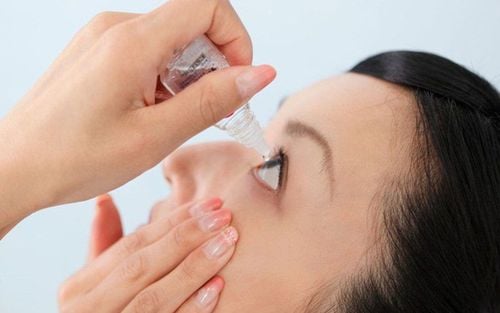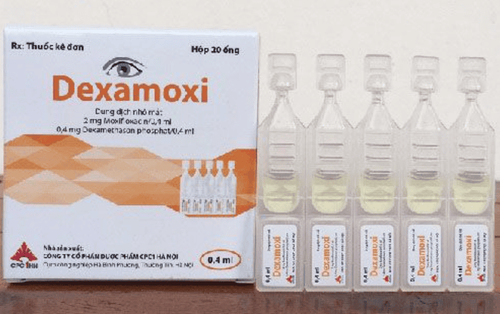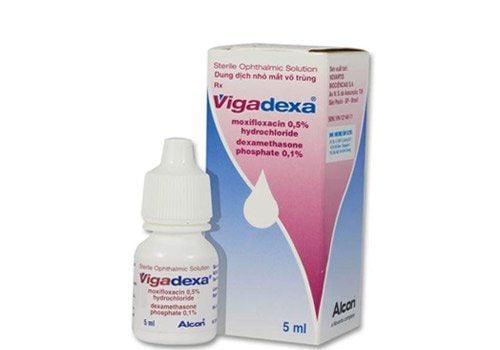This is an automatically translated article.
In some ophthalmic conditions, the doctor may prescribe eye surgery, or do invasive tests and procedures. At this time, suppressing the patient's pain with eye drops is extremely necessary, one of the drugs for this effect is the drug Altacaine. So how does the drug Altacaine work?
1. How does the drug Altacaine work?
Altacaine is an eye drop containing the active ingredient Tetracaine and is used for local anesthetic purposes in ophthalmology. Altacaine eye drops are used as a local anesthetic prior to surgery, certain invasive tests, or eye procedures. Altacaine is used to prevent pain during surgery or invasive procedures in the eye. The active ingredient Tetracaine belongs to the group of local anesthetics, the mechanism of action is to block pain signals at the nerve endings in the eye.
Altacaine is a product to be used only directly or under the supervision of an ophthalmologist.
2. Some notes when using Altacaine drug
Before deciding to use a drug, including Altacaine, the patient needs to understand and weigh the risks and benefits of the drug. The doctor is the one who prescribes it, but deciding whether to use Altacaine or not is up to the patient.
For Altacaine, the patient should consider the following:
History of allergies: Patients should inform their doctor if they have previously had unusual or allergic reactions related to tetracaine, other drugs. anesthetic or any other medicine. Also talk to your doctor and ophthalmologist about any other allergies, including allergies to foods, preservatives or pet dander; Use of Altacaine in Children: Studies on the relationship between age and the effects of Altacaine in children have not been performed, so safety and efficacy have not been established; Geriatrics: There is no information on the relationship between age and the effects of Altacaine eye drops in elderly patients; Lactation: Studies in women have shown that Altacaine poses minimal risks to a nursing infant when used during breast-feeding;
3. Some interactions of the drug Altacaine
Although there are certain drugs that cannot be used together at all due to the existence of harmful interactions, in some cases it is possible to use 2 drugs at the same time even if there is a risk. Interactive. Such cases should be treated by the treating physician to change the dosage or take additional necessary precautions.
When the use of Altacaine is indicated, it is especially important for the patient to remember to let the treating doctor know about all the drugs being used. The following Altacaine interactions have been selected on the basis of their potential significance, and are not necessarily intended to cover all of these product interactions.
Using Altacaine with any of the following medicines is generally not recommended, but if prescribed by your doctor, it can still be used. At that time, the treating doctor can change the dose or frequency of using 1 or both drugs:
Bupivacaine; Hyaluronidase; St John's Wort (St John's Wort). Interactions of Altacaine with food, tobacco or alcohol:
Some drugs should not be taken at the same time or around the time of consuming certain foods because of the risk of interactions. Using alcohol or tobacco with certain active ingredients also has the potential to lead to harmful interactions; Before starting Altacaine eye drops, talk to your doctor about possible interactions between Tetracaine and food, alcohol or tobacco. You have certain medical problems or other medical conditions that may affect the use of Altacaine . Patients using Altacaine should be sure to inform their doctor about any previous medical history, especially cardiovascular problems, because when side effects occur, they can be more serious. normal person.
4. Instructions for using the drug Altacaine
The following instructions for use relate to products containing tetracaine, including Altacaine eye drops. The user should read and carefully review the following instructions:
A trained nurse or healthcare professional will be the one to directly administer Altacaine to the patient. Altacaine will be instilled directly into the patient's eyes; The doctor will closely examine and monitor the patient's progress throughout the course of Altacaine use. Thereby allowing the treating doctor to record the effectiveness of the drug and decide whether the specific patient can continue to use Altacaine eye drops or not; A particularly important issue is to protect the patient's eyes from damage while the anesthetic Altacaine is effective. Patients absolutely do not touch or rub their eyes directly, and do not use any other eye drops without the doctor's approval. Patients should take appropriate measures to protect their eyes from dust, sand, or anything that may cause irritation.
5. Altacaine side effects
Besides the desired therapeutic effects, Altacaine can cause some unwanted side effects. The following side effects have varying rates of occurrence and, if they occur, the person may need appropriate medical attention.
The patient should promptly notify the doctor or nurse if any of the following side effects occur:
Blurred vision; Corneal congestion; Increased sensitivity to light; Intense stinging sensation in the eye; Weep ; Sharp pain in the eye; Red eyes; burning, stinging, itching, red, or irritated eye sensations; Change vision. Other side effects not listed may also occur in some patients taking Altacaine . If any other effects are noted, the patient should immediately consult a doctor for appropriate intervention.
Please dial HOTLINE for more information or register for an appointment HERE. Download MyVinmec app to make appointments faster and to manage your bookings easily.













